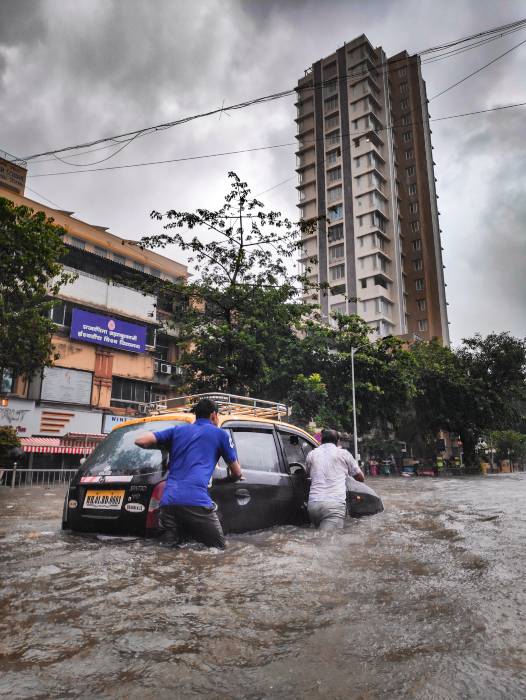Water at heart of disasters due to climate change
For the past 50 years, meteorological, climatic and water risks have been responsible for half of all of the world’s disasters - and climate change is behind many of them.
In a world increasingly affected by climate change, water has become the epicenter of a crisis affecting much of the planet - in very different ways. From unpredictable climate patterns, rising sea levels, flooding and drought, to loss of human and lives and multi-million-dollar economic consequences, most climate change impacts are directly related to water.
What will I learn from this article?
- A summer of intense rainfall
- The data behind water-related catastrophes
- Water and climate change, increasingly spoken in the same breath
A summer of intense rainfall
Germany’s national weather service stated in July that two months of rain had fallen in little more than two days. Belgium, the Netherlands and Luxembourg experienced the same phenomenon.
 On the Asian continent, some regions of central China received more rain between 17 and 21 July than they do on average all year round. Indeed, in just six hours, the water that fell on Zhengzhou, capital of Henan province, amounted to half the annual precipitation. Add to this the havoc caused in Chile and some areas of Spain by the impact of atmospheric rivers.
On the Asian continent, some regions of central China received more rain between 17 and 21 July than they do on average all year round. Indeed, in just six hours, the water that fell on Zhengzhou, capital of Henan province, amounted to half the annual precipitation. Add to this the havoc caused in Chile and some areas of Spain by the impact of atmospheric rivers.
Dangers related to weather, the climate and water are becoming more frequent and intense as a result of climate change. In this article, we related how rising global temperatures impact on the water cycle. The hotter it gets, the quicker water evaporates. As a result, the amount of water circulating in the atmosphere in the form of vapor increases.
The intensification of the water cycle will make extreme climate events even worse. We are talking here about longer periods of drought and more intense and common torrential rain and flooding.
The data shows that, over the past 50 years, meteorological, climatic and water risks have been responsible for half of all of the world’s disasters (including technological accidents), 45% of all recorded deaths and 74% of all economic loss recorded across the world.
“For the past 50 years, meteorological, climatic and water risks represent half of all disasters”
The data behind water-related catastrophes
According to the UN, disasters related to water alone have caused some 1.3 million deaths since 1970. Among the 10 main ones recorded during this period, droughts were the greatest cause of death, followed by storms, floods and extreme temperatures.
As for economic losses, the 10 most damaging catastrophes were storms (USD 521 billion), and floods (USD 115 billion), according to a glimpse of the next UN Atlas on deaths and economic losses, which will be published in full in September. In Germany alone, the 2002 floods caused 16.5 billion dollars in losses and were the most costly event on the continent between 1970 and 2019.
“The average global temperature in 2023 will be between 1.08°C and 1.32°C above the preindustrial level”
Water and climate change, increasingly mentioned in the same breath
Forecasts from the United Kingdom meteorological service put the average global temperature in 2023 at between 1.08°C and 1.32°C above the preindustrial level, not far off the 1.5°C maximum tolerable temperature rise by the end of the century, as set out by the Paris Agreement.
 Recent climate models predict that, for every degree of warming, the Earth’s water cycle could become 7% more intense, which, in practice, means that humid areas would become 7% more humid and dry areas 7% drier on average.
Recent climate models predict that, for every degree of warming, the Earth’s water cycle could become 7% more intense, which, in practice, means that humid areas would become 7% more humid and dry areas 7% drier on average.
Percentages aside, the effects can already be verified on the ground. The floods in Pakistan in 2022, in which at least 1,700 people died and 33 million were affected, are one evidence of this.
The other side of the coin is drought. In East Africa, rainfall has been below average for four seasons running, causing a humanitarian crisis affecting millions of people, devastating farming and killing livestock, above all across Ethiopia, Kenya and Somalia.
The dangers related to the weather, climate and water are increasing in frequency and intensity as a consequence of climate change. It is becoming increasingly urgent that measures are taken to mitigate climate change and protect our water resources to guarantee a sustainable future.
We need to work flat out to achieve decarbonization and support the new generation of renewable, clean energy. Governments and corporations must also rise to the challenge and plan more resilient infrastructure and mitigate water scarcity in the many places suffering from hydric stress, through water treatment and desalination.
Sources:







